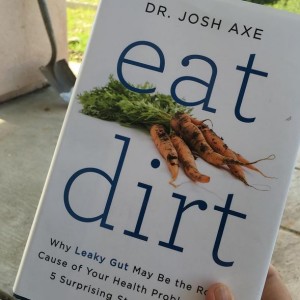Disclaimer: This post contains both medical information (I don’t make medical claims here; I just point you to a medical resource that you might want to investigate if you have skin related medical concerns) and affiliate links (if you decide to purchase this book through my link, which may earn me props. While I don’t always include affiliate links when I put you on to something good, I only promote information that I feel would benefit you like it has me.)
I received this question in my inbox yesterday:
Renee – I’ve got weird patches all over my arms, legs, neck and hands. They started on my hands and were super mild when I saw my dermatologist. He said it was a form of eczema and prescribed an ointment. It doesn’t help and I don’t want to try any more chemicals. Do you think Beesilk will help? -Colleen
It’s due to these kinds of questions that I try to keep tabs on research related to identifying the root causes of eczema and other skin conditions.
What I’m Currently Reading {hardcover book}
 I am always on the look out for research related to skin conditions like Colleen describes because I know it will likely take more than coconut oil, beeswax and shea butter to fix her eczema. I found quite a few answers in Dr. Axe’s new book Eat Dirt: Why Leaky Gut May Be the Root Cause of Your Health Problems and 5 Surprising Steps to Cure It.
I am always on the look out for research related to skin conditions like Colleen describes because I know it will likely take more than coconut oil, beeswax and shea butter to fix her eczema. I found quite a few answers in Dr. Axe’s new book Eat Dirt: Why Leaky Gut May Be the Root Cause of Your Health Problems and 5 Surprising Steps to Cure It.
Although the book focuses on all kinds of symptoms of leaky gut, like arthritis, depression, migraines, fatigue and muscle pain, I’m honing in on skin conditions, specifically psoriasis, eczema and rashes.
Let me start with 5 year old Blake.
Blake is one of Dr. Axe’s patients, who came in with his mother:
“He’s itchy all the time,” his mother said. “We’ve seen other doctors, and they want to put him on steroids and antibiotics. That seems awfully drastic for a young boy.” She’s right. They would likely have started with a prescription-strength corticosteroid cream.
Blake had rashes that covered his arm and face, his skin was swollen and red, and his skin dermatitis was about to crust and flake off.
THIS is where I tell you that our products may not work for Blake.
Beesilk hard lotion bars, Beesilk Jr or Simply Soothing Rash Cream may likely help with the itching and redness, but Blake’s mom needs to go deeper to get Blake some relief.
What did Dr. Axe conclude after a thorough examination and a look at Blake’s health history?
“… the boy’s body was experiencing inflammation caused by allergic reactions to the foods he ate and household toxins he was being exposed to.” – Dr. Axe
The 5 Types of Gut Issues (causes and symptoms)
Dr. Axe outlines various protocols for symptoms based on what gut type issue the patient has. I found this extremely helpful because many gut-related books seem overwhelming when it comes to where to start. He has a gut type quiz and the results should narrow down your gut issues to one of the following:
- Candida Gut (caused by a high-sugar diet, antibiotics and chronic anxiety, the warning signs include extreme fatigue, cravings for sweets, bad breath, brain fog and white coating on the tongue.)
- Stressed Gut (caused by emotional stress, thyroid issues, adrenal fatigue and high cortisol levels, the warning signs include trouble waking up, depression, bone loss, inflammation, increased allergies…)
- Immune Gut (caused by food sensitivities, gluten, and dairy products. Warning signs include arthritis, eczema, psoriasis, migraines and muscle pain.)
- Gastric Gut (caused by underchewing, overeating, and a slow digestive system. The warning signs include bloat and acid reflux.)
- Toxic Gut (caused by overconsumption of bad fats and toxicity from the environment, personal care products, and processed foods. Warning signs include gallbladder disease and skin inflammation issues like rosacea or neurological diseases.)
That list might overwhelm you, but once you read through each section, I assure you that you’ll be closer to nailing the issue you’re plagued with.
Let’s get back to five year old Blake.
Dr. Axe suspected he had food sensitivities, most likely to gluten and casein, and he had allergic reactions to shampoo, laundry detergent and maybe even the linen in his bedsheets.
In order to confirm his suspicions, Dr. Axe tested him:
I had Blake take an IgG food intolerance test and an IgE allergy test, blood and skin tests that help me zero in on the cause of immune response, and the results were not surprising: Blake was sensitive to cow’s milk, gluten, strawberries, egg whites, and tree nuts and had several environmental allergies. Like so many children I’d seen, Blake’s multiple food and environmental sensitivities were the outward manifestations of leaky gut. – Dr. Axe, page 32.
Dr. Axe advised that he eat a gut-healing diet that included pears, blueberries, healthy fats (avocados, coconut oil), grass-fed beef, free-range chicken, steamed carrots, cauliflower and squash. He removed the food allergens from Blake’s diet. Because of his environmental allergies, he advised that Blake’s family toss their home-cleaning and body products and replace them with home-made versions, add certain essential oils, and add bentonite clay to his diet. (By the way, this is where the title/subject of the book comes in – he advises to literally eat dirt… as in bentonite clay.)
Three weeks later:
The dermatitis that covered Blake’s body and the eczema on his cheeks had disappeared.
Dr. Axe reminded Blake’s mother that coming in contact with household chemicals, including antibacterial soap, could cause his skin to react again. His gut lining would continue to get stronger but they still had to be vigilant in avoiding the triggers.
Now, I am obviously not a doctor and I can’t promise that following Dr. Axe’s protocol outlined in his book will guarantee the healing of eczema, psoriasis, or rosacea. But what Eat Dirt outlines is a very thorough break-down of the various forms of a leaky gut and what can be done about it. Because I have multiple questions via email come in about these skin conditions, I wanted to have a source to point people to. I do get emails from people who have been able to heal their skin conditions by identifying and eliminating food triggers (primarily eggs, dairy and nuts) and I firmly believe that there’s hope for people who can give it a try.
What I appreciate about Eat Dirt
- It’s not just about chomping down dirt for dinner. The idea is to get back to nature… eat what grows in your area, eat foods that get exposure to local pollen, eat less processed and more fermented foods… and when you’re ready to try it, take a teaspoon of bentonite clay three times a day.
- Each of the four gut types mentioned above has a whole chapter devoted to it, outlining the causes, the right diet, the right supplements and “good practices” to follow. There’s even a daily routine schedule with each gut type, beginning at 7 am and ending at 10 pm, with lifestyle and eating suggestions. It’s not just about food.
- There’s enough of a medical explanation throughout the book to know “why” your body is acting the way it is, without overdoing the complicated doc-speak that requires a medical glossary tab open.
- Recipes at the end of the book are easy to follow, with ingredients that are accessible to most people.
- This: “By living in a squeaky-clean bubble and turning germs and dirty into villains to be destroyed or avoided at all costs, we’ve kept some of our most powerful allies for health at arm’s length – and the devastating ramifications are piling up all around us.” He goes on to say that there’s been at least a sevenfold increase in rates of autoimmune disorders like Crohn’s disease and Multiple Sclerosis and it’s directly related to the lack of beneficial microbes in our gut. (p 49)
- Currently, there are $300′ worth of bonuses that come with the purchase of this book.
Whether you use Dr. Axe’s book or research on your own, I recommend that if you suffer from psoriasis, eczema, itchy skin or rash, go find out if you have other symptoms of leaky gut and see if that’s the cause.


